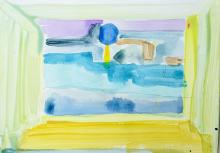iGaveli
There is no global warming. Humanity is not plagued by recurring floods and droughts. There are no heat waves, hurricanes, and tornadoes. Glaciers are not melting, sea levels are not rising, average ocean and earth temperatures are not increasing, the relief of the world's continents is not changing, and human activities are not contributing to the greenhouse effect. We should and could pretend to think so... but the paintings of Indre Gaveli, artist name iGaveli (b. 1980), invite us to think and pay attention to the changes of our continent, environment and nature. iGaveli joins the Climate Change Art's ambition to engage the community to reflect on their daily actions, to raise awareness of the social and political issues of global warming by making data "alive and accessible".
iGaveli's task is to interpret in a contemporary way the changing human habitation over time, to draw attention to the environment around us based on the change in the relief of the continents recorded by radar, and to express in colour the changing natural terrain. To create a medium for reflection ... why is change happening?
iGaveli carefully studies the process of change, documenting it through observation, focusing on the changes, analysing the prehistory of the sites, delving into the before and after situation. All the collected archival data and images, documenting real historical events as a reference point for the terrain, seem to be "integrated" into iGaveli's paintings, combining the visual impressions experienced into a single whole.
iGaveli's work is like a beautiful, nostalgic, mysterious combination of shapes, evoking the feeling of "happiness". However, the highlighted stain in each painting disrupts all the beauty and goodness it captures, drawing attention to a mysterious threat, a danger. This is not only a reflection on the changes on relief of the world, but also a perception of the spontaneous "awakening".
iGaveli is influenced by the methodology learned at Mykolé's art studio based on the École nationale supérieure des Beaux-Arts in Paris: to convey the analysis of the plot and personal conclusions in "your own language", on the basis of "desktop" and social networking material. To hypothesise about global warming, taking into account the changes recorded in sketches, diagrams, imaginary spaces, and to show this intuitively in the colour and graphic language of iGaveli's work. iGaveli is all about the perception of space,
volume, and the image in the language of colour and the expression of authenticity. iGaveli uses "beautiful colours that are easy to understand". Helen Frankenthaler's paintings and approach influence iGaveli's colour palette:
"I think people are very threatened by the word beauty today. In some circles the word implies shmaltzy and passé. But the darkest Rembrandts and Goyas, the most somber music of Bethoven, the most tragic poems by Eliot are all full of light and beauty. Great, moving art that speaks the truth is beautiful art." - Helen Frankenthaler, 1989.
iGaveli is most impressed by the paintings of innovative artists. Sally Gabori's fascinating abstract paintings began at the age of 81 to represent her country on the south side of Bentinck Island in Queensland, Australia. iGaveli is interested in her abstract expressionism and gestural abstraction of her country's sea, sky and land. The vivid coloured landscapes of author David Hockney inspire her to be bold with bright colours and discover the expressiveness of colourful lines. Richard Diebenkorn's geometric, lyrical abstraction captivates with landscapes seen in the format of geometric shapes, while Wayne Thiebaud's play of blue shadows inspires with a range of colours. Harold Ancart's organic abstractions of flowers and landscapes, creating a surreal or science fiction theme, catch the attention of iGaveli. iGaveli does not try to replicate real images. As Luc Tuymans said, "if you use a projector, it will look perfect. But then there are no mistakes. In fact, these mistakes are good."
The techniques learned in Mykolé's art studio, the synthesis of the analysis of different authors, iGaveli's unique perception of colours and images, and the relevance of the social and political issues of global warming, lead her to put forward a hypothesis about the impact of climate change and to refute/confirm it in the language of her paintings.









